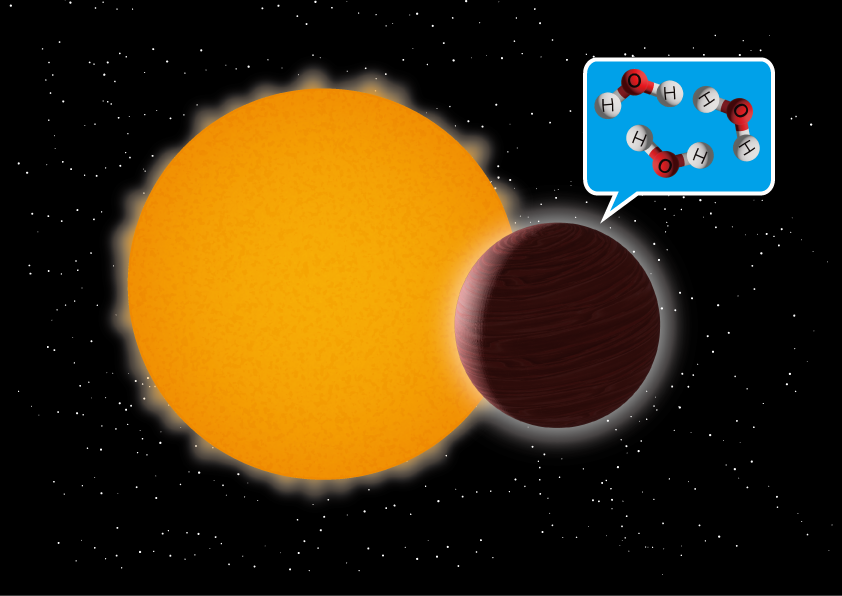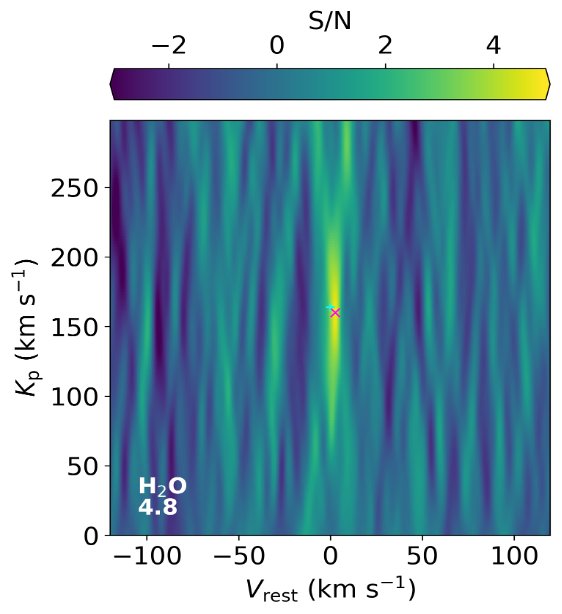
A team of astronomers, led by Sayyed Ali Rafi, a graduate student from the University of Tokyo, has recently discovered evidence of water vapor (H2O) in the atmosphere of the hot Saturn, HD 149026 b (Figure 1). This exoplanet, located about 250 light years from Earth in the Hercules constellation, is a type of hot gas giant similar in size to Saturn but orbits extremely close to its host star. It orbits a metal-rich evolved star, HD 149026, nearly 10 times closer than Mercury’s orbit around the Sun, resulting in a year that lasts only about 2.9 days! This proximity causes the temperatures of such hot gas giants to soar above 1500 Kelvin. Specifically, HD 149026 b has an equilibrium temperature of approximately 1700 Kelvin, hot enough to melt even the strongest steel.
This paper will be published in The Astronomical Journal on August 5th, 2024.
To detect atmospheric signatures from the planet, the team used a technique called transmission spectroscopy. When the planet transits or passes in front of its host star relative to the observer on Earth, some of the star’s light passes through the planet’s atmosphere. This starlight is absorbed by various gases in the atmosphere, creating a planetary absorption spectrum that is imprinted on the stellar spectrum. By separating the stellar spectrum from the planetary spectrum, such as by subtracting the spectrum observed outside of transit (where there’s no atmospheric absorption from the planet), the atmospheric signatures of the planet can be identified.
One major challenge in observing exoplanetary atmospheres is the extremely high contrast between the bright star and the dim planet. This makes the planet’s atmospheric signatures difficult to detect, often buried below the stellar photon noise. The strength of the planet’s signatures would be stronger if we observed planets with either higher temperatures (resulting in more extended atmospheres and easier detection), closer distances to their host stars (making it easier to separate the stellar and planet spectra), or a combination of both. Hot gas giants possess both these properties, making them ideal targets for transmission spectroscopy observations, though their atmospheric signatures remain challenging to detect.
“We can boost the exoplanet signal by combining the information of hundreds or thousands of weak spectral absorption lines that are individually resolved in high-resolution spectroscopy using cross-correlation. This is one of the most successful methods used to characterize the atmosphere of exoplanets so far allowing us to take a peak of the atmosphere of alien worlds”, explains Dr. Stevanus Kristianto Nugroho from Astrobiology Center, who co-authored this study.
Using this technique, the team analyzed high-resolution transmission spectroscopy archival data from CARMENES, a high-resolution spectrograph installed at the 3.5-meter Calar-Alto Observatory in Spain. They focused on the near-infrared wavelength range (0.97 – 1.7 μm) of the spectrograph to search for signs of H2O and HCN (hydrogen cyanide), which have strong absorption features in this range. “We found an evidence of H2O in HD 149026 b’s atmosphere at an S/N of 4.8 whilst we cannot find anything related to HCN (Figure 2)”, the lead author, Rafi, said. Last year, interestingly, the James Webb Space Telescope (JWST) also detected H2O on HD 149026 b, but from its dayside rather than during transit. This complementary finding supports the presence of water vapor in the planet’s atmosphere, indicating that water is present in different regions of the planet’s atmosphere. The team emphasized that their discovery, however, still needs to be confirmed by more transit observations follow-up. As for HCN, the non-detection, the team outlined in their work, might be attributed to the data’s S/N which perhaps might not be enough to detect the molecule.

So, why search for H2O and HCN? In the atmosphere of hot gas giants like HD 149026 b, if the carbon-to-oxygen ratio (C/O) is less than one (indicating that oxygen is more abundant than carbon), H2O and carbon monoxide (CO) are the most abundant oxygen and carbon-bearing species. If the C/O ratio is greater than one, H2O becomes less abundant, and HCN becomes more prevalent, alongside CO, whose abundance remains relatively constant. By finding and determining the abundance of these gases, scientists can measure the atmospheric C/O ratio, which is crucial to infer the formation and evolution history of gas giant planets like HD 149026 b. “This detection of water vapor on a hot Saturn-like exoplanet offers new clues about its atmospheric dynamics and orbital properties and takes us one step closer to understanding planetary formation”, explains Dr. Alejandro Sánchez-López from Instituto de Astrofisica de Andalucia and co-authored this work.
Studying the atmosphere of HD 149026 b is particularly important due to its unique characteristics. This planet has an anomalously large core, estimated to be up to around 110 Earth masses, which challenges existing planet formation models such as gravitational instability and core accretion. These models typically predict much smaller cores for gas giants, so forming a core of this size suggests unusual conditions or processes. Several theoretical scenarios have been proposed, and any follow-up atmospheric observations of this planet could help support one of these theories or even suggest a new one.
Graduate students play a pivotal role in the field of exoplanetary research, as demonstrated by the work of Rafi and his team. Their work highlights the significant contributions these young researchers make. Graduate students’ ability to conduct such study using data from the state-of-art instrument is essential for advancing our understanding of distant worlds, thus highlighting their important role in this rapidly evolving scientific discipline.
PUBLICATION
Journal: The Astronomical Journal
”Evidence of Water Vapor in the Atmosphere of a Metal-Rich Hot Saturn with High-Resolution Transmission Spectroscopy”
Authors: S. A. Rafi, S. K. Nugroho, M. Tamura, et al.
DOI: 10.3847/1538-3881/ad5be9
URL: https://doi.org/10.3847/1538-3881/ad5be9

